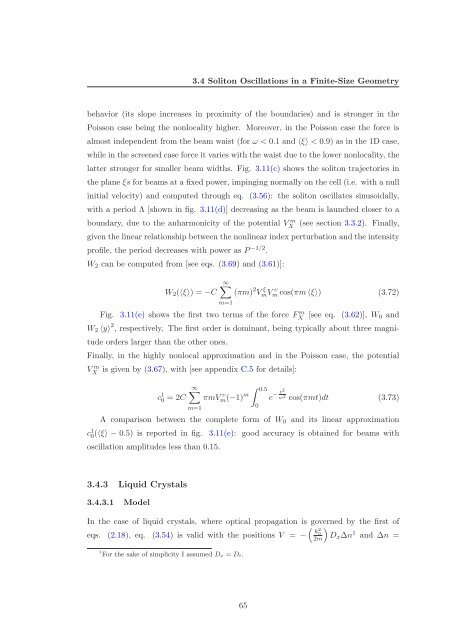Solitons in Nonlocal Media
Solitons in Nonlocal Media
Solitons in Nonlocal Media
You also want an ePaper? Increase the reach of your titles
YUMPU automatically turns print PDFs into web optimized ePapers that Google loves.
3.4 Soliton Oscillations <strong>in</strong> a F<strong>in</strong>ite-Size Geometry<br />
behavior (its slope <strong>in</strong>creases <strong>in</strong> proximity of the boundaries) and is stronger <strong>in</strong> the<br />
Poisson case be<strong>in</strong>g the nonlocality higher. Moreover, <strong>in</strong> the Poisson case the force is<br />
almost <strong>in</strong>dependent from the beam waist (for ω < 0.1 and 〈ξ〉 < 0.9) as <strong>in</strong> the 1D case,<br />
while <strong>in</strong> the screened case force it varies with the waist due to the lower nonlocality, the<br />
latter stronger for smaller beam widths. Fig. 3.11(c) shows the soliton trajectories <strong>in</strong><br />
the plane ξs for beams at a fixed power, imp<strong>in</strong>g<strong>in</strong>g normally on the cell (i.e. with a null<br />
<strong>in</strong>itial velocity) and computed through eq. (3.56): the soliton oscillates s<strong>in</strong>usoidally,<br />
with a period Λ [shown <strong>in</strong> fig. 3.11(d)] decreas<strong>in</strong>g as the beam is launched closer to a<br />
boundary, due to the anharmonicity of the potential V m X<br />
(see section 3.3.2). F<strong>in</strong>ally,<br />
given the l<strong>in</strong>ear relationship between the nonl<strong>in</strong>ear <strong>in</strong>dex perturbation and the <strong>in</strong>tensity<br />
profile, the period decreases with power as P −1/2 .<br />
W2 can be computed from [see eqs. (3.69) and (3.61)]:<br />
W2(〈ξ〉) = −C<br />
∞<br />
(πm) 2 V ξ mV υ m cos(πm 〈ξ〉) (3.72)<br />
m=1<br />
Fig. 3.11(e) shows the first two terms of the force F m X [see eq. (3.62)], W0 and<br />
W2 〈y〉 2 , respectively. The first order is dom<strong>in</strong>ant, be<strong>in</strong>g typically about three magni-<br />
tude orders larger than the other ones.<br />
F<strong>in</strong>ally, <strong>in</strong> the highly nonlocal approximation and <strong>in</strong> the Poisson case, the potential<br />
V m X<br />
is given by (3.67), with [see appendix C.5 for details]:<br />
c 1 0 = 2C<br />
∞<br />
πmV υ m(−1) m<br />
m=1<br />
0.5<br />
0<br />
t2<br />
−<br />
e w2 cos(πmt)dt (3.73)<br />
A comparison between the complete form of W0 and its l<strong>in</strong>ear approximation<br />
c1 0 (〈ξ〉 − 0.5) is reported <strong>in</strong> fig. 3.11(e): good accuracy is obta<strong>in</strong>ed for beams with<br />
oscillation amplitudes less than 0.15.<br />
3.4.3 Liquid Crystals<br />
3.4.3.1 Model<br />
In the case of liquid crystals, where optical propagation is governed by the first of<br />
eqs. (2.18), eq. (3.54) is valid with the positions V = −<br />
1 For the sake of simplicity I assumed Dx = Dt.<br />
65<br />
k 2 0<br />
2m<br />
<br />
Dx∆n 1 and ∆n =
















